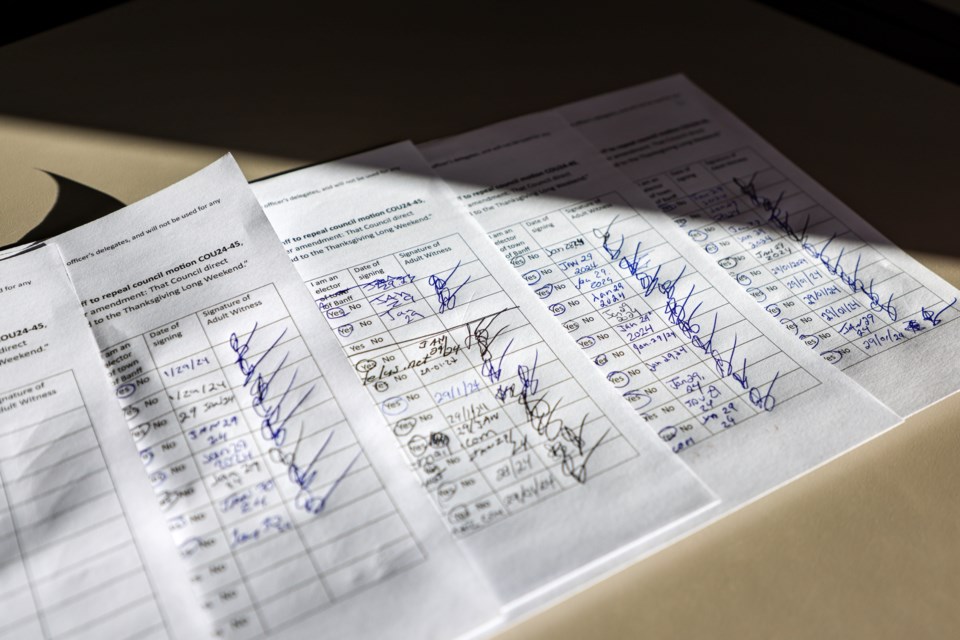A petition with more than 1,000 signatures opposing the pedestrian zone has been delivered to the Town of Banff, which will likely lead to a plebiscite on the divisive issue in the community.
If the petition is deemed to meet all the requirements under the Municipal Government Act, council must decide to repeal the pedestrian zone or hold a binding plebiscite on the question under the Municipal Government Act (MGA).
The Town of Banff is currently working to determine if the petition, which was handed in on Friday (March 1), is sufficient.
Leslie Taylor, a former Banff mayor and town councillor who took the lead on the petition, said 1,086 signatures were collected by 33 grass-roots volunteers, meeting the 10 per cent requirement.
If the higher population figure from the Town’s website is taken, she said 10 per cent would be 966 people, and if the lower federal government population number is considered, 10 per cent would be 830.
“For comparison, 2,060 people voted in the last municipal election,” said Taylor.
On Jan. 17, Banff council voted 5-2 to move ahead with the car-free pedestrian zone on the 100 and 200 blocks of Banff Avenue from the May long weekend until Thanksgiving weekend.
This followed an 11th hour letter from Parks Canada saying commercialization of public spaces with restaurant patios and retail kiosks flouts national park policy and law.
Taylor said Banffites have been able to see for themselves what happens when the pedestrian zone is in place over the past four summers.
“Many like the idea of a pedestrian area. But they also see the negative impacts on the rest of our community, such as major traffic congestion being moved to residential streets,” she said.
“Many feel the negatives outweigh the positives, and so they signed the petition.”
Taylor hopes the issue will go to a plebiscite.
“People have had every opportunity over the past four years to weigh the pros and cons of a summer pedestrian zone on Banff Avenue,” she said.
“They have been able to see how the proposed solutions to negative impacts play out. They’re ready to have their say.”
Taylor said every signature was witnessed by one of the 33 volunteers, who also had to do a legal form known as Affidavit of Witness to say that they did this properly.
“It’s not an easy process to do one of these petitions,” she said.
After a council resolution is passed, the MGA provides 60 days to petition that resolution by getting signatures from 10 per cent of the population and everyone who signs has to be 18 years of age or over, a Canadian citizen, and a resident of Banff.
“So I think it's notable that we reached the 966 level around 28 days after the resolution was passed,” she said. "We reached it about 18 days after the petition became available for signing.”
Town Manager Kelly Gibson said he has convened a small team to start the process required by the MGA to review whether all the conditions for petition have been met.
“The team will review the sufficiency of the petition according to guidelines provided by Municipal Affairs,” he said.
Gibson said the Town will keep all names, signatures, addresses and any other personal information private and confidential, in accordance with the Freedom of Information and Protection of Privacy Act.
“Only the members of the delegated team and, potentially, legal advisors, will see the information, which can only be used to validate the petition,” he said.
“No other employees, members of Banff town council or third parties will have access to the petition.”
Within 45 days of the date when the petition has been filed, which will be April 14, Gibson is required under the MGA to make a declaration as to whether or not the petition is sufficient.
If the petition is declared sufficient, council must, within 30 days of declaration, repeal the bylaw or set a date that is within 90 days for a vote of the electors.



